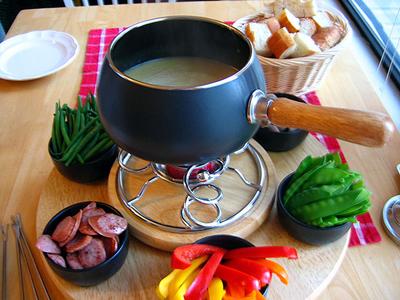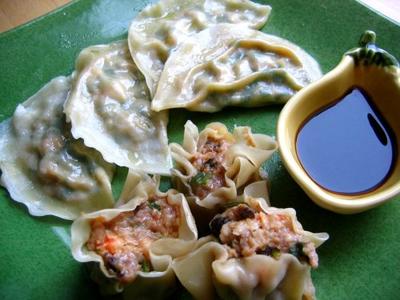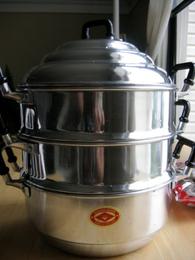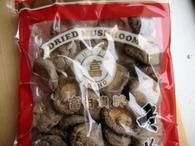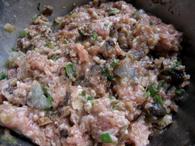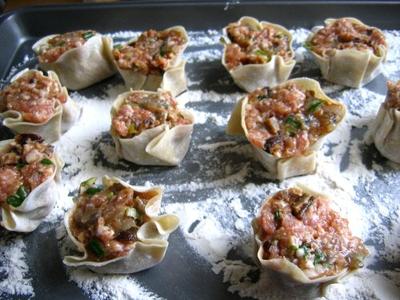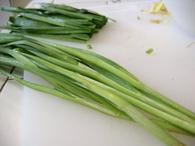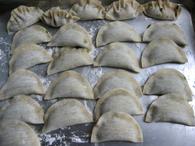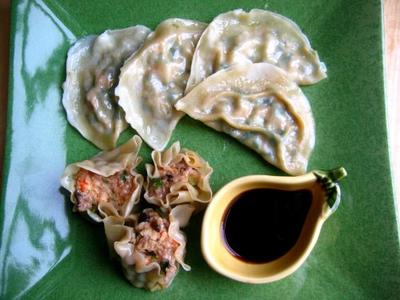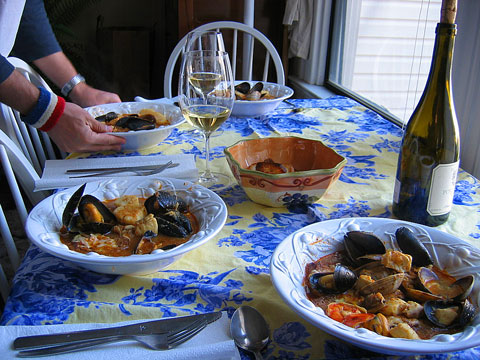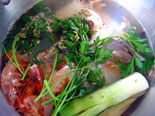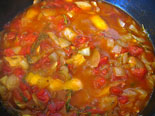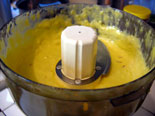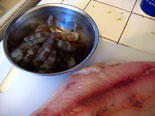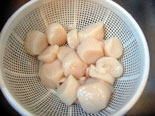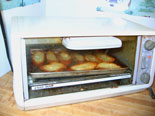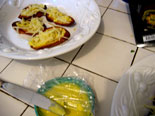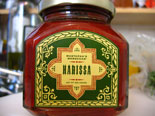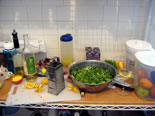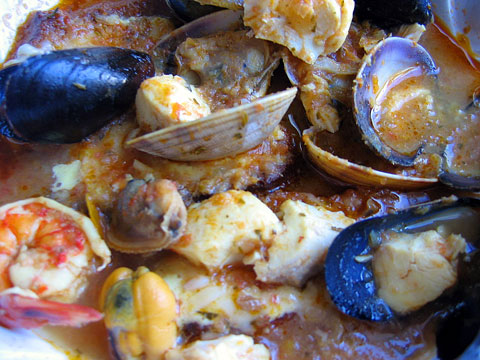September 19, 2004
IMBB VIII: Wine
I didn't think I was going to be able to participate this time 'round -- the theme is to cook with spirit and most importantly, spirits -- wine, liqueur, anything (edible?) with alcohol in it -- but I managed to pull it off today. This weekend has been one of running around, late nights, performances, and seeing old friends and I didn't think I'd have the time to actually get to the stove. But somehow it all came together late this afternoon. I've been wanting to use my Fondue set, and these past few days have been considerably cooler in San Francisco to warrant making some hot melted cheese yumminess. What does that have to do with wine? It's part of any classic fondue recipe of course!
The recipe is as follows:
1 chopped garlic clove
1 cup dry white wine
2 cups grated Gruyere
2 cups grated Emmentaler
2 T flour
1/2 T cornstarch
1 T kirsch
dash of nutmeg
salt to taste
Place wine and garlic into fondue pot, bring to a boil. Toss the cheese with the flour, and once wine mixture is boiling, throw the cheese into the pot in handfuls, stirring after each handful until the cheese is melted before adding more.
Once all the cheese has melted, add the cornstarch mixed with the kirsch. Add nutmeg, salt and transfer fondue to stand over a candle or small pot of sterno.
Serve with cubed pieces of french baguette, slices of red bell peppers, blanched snow peas and haricot verts, baby carrots and bits of sausge (I served kielbasa and bratwurst).
For dessert I broke up about 8 oz. of dark bittersweet chocolate, and melted it with a cup of heavy whipping cream and 3 T of Cointreau. I served the chocolate fondue with strawberries, bosch pears and biscotti. I didn't get to take many pictures since we got engrossed in looking for a random lost remote control (we were about to pop in the documentary Outfoxed), and began to dig in and watch before realising we had quite forgotten the photographs...
IMBB VIII: Raise Your Spirits High, or cooking with wine, or any other kind of spirit
hosted by Donna Marie Zotter of There's a Chef in My Kitchen
IMBB I: @ Il Forno, soups
IMBB II: @ Chocolate & Zucchini, tartines
IMBB III: @ Shiokadelicious, cakes
IMBB IV: @ Chez Pim, rice
IMBB V: @ Mum-Mum, fish
IMBB VI: @ Too Many Chefs, grilling & BBQing
IMBB VII: @ Life in Flow, dumplings
August 21, 2004
IMBB VII: Dumplings
This is the 2nd time in a row that I find myself out of town for IMBB, and this week the theme is Dumplings, hosted by Redbeard of Food Porn Watch... I really enjoy these challenges, as I find that I can push myself to create something I've never attempted before -- such as Bouillabaisse for instance, for the 5th installation of Is My Blog Burning?, held by Wena of Mum-Mum...
So I still wanted a chance to participate, and made my choice early. I was going to attempt Dim-Sum. Translated as "a little bit of heart," or "touching the heart," or even "from the heart," it's a series of small dishes ("Chinese tapas") containing 3 or 4 dumplings or buns, that are mostly steamed or fried. But Dim-sum dishes are also comprised of spare-ribs and chicken feet, pieces of crisped taro cake or bowls of rice porridge. We tradionally take Dim-Sum as brunch -- restaurants tend to serve it anywhere from 11am to 2-3pm. One of my earliest memories of enjoying Dim-Sum was when I, 7 at the time, spent a holiday in Hong Kong with my parents. We ate at one of the floating restaurants in Aberdeen Harbour, possibly at the Jumbo Tai Pak Restaurant -- the biggest and grandest of all. I was definitely very excited at the prospect of dining on a boat, expecting at any minute that waves might send tables and patrons skittering all over the restaurant. No such luck. The boat was huge and the harbour mild; nonetheless the Dim-Sum was extremely tasty, and I enjoyed myself thoroughly.
I didn't purchase the traditional bamboo steamers for the occasion -- those small little vessels in which Dim-Sum is traditionally served, but I did get to Kamei on Clement to purchase a nice neat steaming pot, with 2 levels of steamer trays...
I made Siu-Mai -- the quintessential Dim-Sum dumpling of ground pork, mushroom and shrimp; and a less-traditional Scallop, Shrimp and Chive dumpling.
Siu-Mai recipe:
4 dried chinese mushrooms, soaked in hot water for 15 minutes
3/4 lb. ground, fatty pork
1/2 lb. shrimp, coarsely chopped
1/2 cup chopped green onion
1 tablespoon minced ginger (I used less - perhaps a tsp.)
1 tablespoon oyster sauce
1 tablespoon soy sauce
1 tablespoon Chinese rice wine or dry sherry
1 tablespoon cornstarch
2 teaspoons sesame oil
1/8 teaspoon white pepper
1 package of about 30-40 round dumpling wrappers
Cooking oil
Chop up the mushrooms and mix all the ingredients together in a large bowl. Cover with plastic wrap and let the mixture marinate in the refrigerator for 2 hours. Towards the end of your 2 hours, fill your steamer with water and set it over heat to boil.
When you're ready to form the dumplings, sprinkle some flour on a cookie sheet, and dust hands with flour. Take a round wrapper, and using a teaspoon, begin with a small mound of the pork mixture in the center, and begin to tuck the center into a loosely formed fist (as if you were holding an ice-cream cone), filling the wrapper with more meat as you go. You are in essence making a little basket of the wrapper in the hollow of your fist.
Once you're done, dip the bottoms of the siu-mai into some oil and place in the steamer, making sure not to let the dumplings touch. Steam for about 15-20 minutes.
What I would change: my Siu-Mai were huge - perhaps just slightly smaller than golf balls! I'd make them tinier next time, going easy on the filling; and add an egg or two to the mixture above for better binding...
Scallop, Shrimp and Chive Dumpling recipe:
1/2 lb sea scallops
1/4 lb shrimp
1 bunch garlic chives (use as much or as little as you like)
1 t. minced fresh ginger
2 T. Chinese rice or sherry
2 t. soy sauce
2 T. cornstarch
1 t. Asian sesame oil
1/2 t. salt
1/8 t. white pepper
thin dumpling wrappers (I used the ones left over from the siu-mai)
Coarsely chop the scallops and the shrimp. Finely chop the chives and sautee in a bit of oil until just wilted. Mix everything in a large bowl. (I made the mistake of using the food processor, and the mixture turned out to be a bit too grainy...not the greatest texture.) Prepare a floured cookie sheet. Stuff the dumpling skins by placing a bit of filling in the center of the wrapper, and folding the edges in half to form little pillows. Either lightly oil the pillows and the bottom of the steamer. Steam dumplings for 15 minutes.
Serve with soy sauce mixed with a little vinegar.
IMBB VII: You're Just the Cutest Little Dumpling!, hosted by Redbeard @ Life in Flow
IMBB I: @ Il Forno, soups
IMBB II: @ Chocolate & Zucchini, tartines
IMBB III: @ Shiokadelicious, cakes
IMBB IV: @ Chez Pim, rice
IMBB V: @ Mum-Mum, fish
IMBB VI: @ Too Many Chefs, grilling & BBQing
July 29, 2004
IMBB 7
Redbeard of Life in Flow hosts the 7th edition of IMBB with a lil' Dumpling theme:Dumpling. A term of endearment. A catch-all name for any european mash of starches rolled into a ball. Or perhaps some noodle filled with tasty meat. Or the english name for any asian dish consisting of a wonton-like wrapper stuffed with damn near anything and pan fried. Or steamed. Or deep fried. Or baked. Or a dough wrapped around fruit, baked, and served as dessert. Perhaps in a pudding, even!
Date's set for 22 August 2004. I'm supposed to be in SoCal with the family, but we'll see what I'll be able to do... I also wonder how many folks will be submitting Dim Sum related entries...
July 18, 2004
IMBB VI: Grillers (and Barbecuers) Delight
Props to Too Many Chefs for hosting this month's Is My Blog Burning #6 -- they write, "If it's got barbecue sauce or grill marks on it, we want to sample it." As I don't have a BBQ (but have been to many, many, many BBQs this year), I decided to use my (rarely-used) grill pan instead. The following entry could have worked for last month's IMBB V, as I decided to grill some fish for this round.
Here then, is the recipe for Grilled Halibut, Scallops, & Baby Bok Choy with Garlic Black Bean Sauce
I used a recipe from the August issue of Bon Appetit, and used a black-bean garlic sauce marinade for halibut. The original recipe called for pork chops, so I toned down the marinade a bit to address the more delicate flavours of fish.
Fish (for 2)
1 lb. Halibut fillets
1/2 lb. large sea scallops
4 stalks of baby bok choy, cut in half
Marinade
1/4 cup Lee Kum Kee garlic black bean sauce
1.5 Tbs. Light soy sauce
1.5 tsp. sesame oil
1.5 tsp. finely minced ginger
3 generous cloves of garlic, chopped
1/8 cup Chinese Rice Wine
Mix marinade in a bowl, reserving some 5 Tbs. of the sauce. Marinate the fish and scallops in the marinade, some 10 minutes. Bush the cut sides of the baby bok choy with the reserved marinade. Heat up and oil the grill pan. When the pan smokes, add the halibut fillets and scallops (cooking in batches if necessary). Cook each side for about 3-5 minutes each, slightly less for the scallops. (Try not to move the fish or scallops before 3 minutes have elapsed, as they have a tendency to stick to the grill pan.
After the fish is cooked, place the vegetables, but side down into the grill pan. When tender (around 5 minutes), remove from pan.
Serve the fish fillets with around 3 large scallops and several half-stalks of baby bok choy. If you're not on Atkins, choose your carbohydrate -- either rice or couscous. I had the latter.
A side note: after reading Barrett's post about how smokey his kitchen got after his own grill pan dinner, and certainly after my own experience with my pan, I now understand why I so rarely use it. Food tends to get stuck to the bottom, and most inevitably burns. The resulting charred mess emits a not insignificant amount of smoke, and, if not careful you and your apartment could soon be engulfed in a hazy fog. Luckily for me I got to open many windows in the flat, and the smoke soon dissapated.
July 08, 2004
Taking Note
July 18th is the 6th installation of IMBB, hosted by Too Many Chefs. The challenge: BBQing and Grilling. I don't have a BBQ, but god knows I've been to too many backyard soirees a la capoerista this year... I may just end up using my grill pan, however ... we'll see ...June 21, 2004
IMBB V update
If you're wondering about the rest of the IMBB entries on yummy fish and fish-related dishes, Wena has gotten them posted here. I love that the Italians - Alberto of Il Forno (who started the IMBB meme) and Carlo of La Cena -- made squid (or in Carlo's case, moscardino -- baby octopus) dishes -- one of my favourite seafoods.
June 18, 2004
Is My Blog Burning V: Fish!
Wena hosts IMBB this weekend, scheduled for the 20th, but as I am going to be awayI agonised quite a bit over whether to make a Cioppino or a Bouillabaisse. I had my heart set on some sort of seafood stew, and both are of the same genesis -- fisherman's food, a melange of what was cheap and plentiful, made with creatures that were not always desirable to the city elite. As a San Franciscan, I rather felt obligated to make something regional, something resonant with my beautiful adopted city - I researched Cioppino, and read Reed Hearon and Peggy Knickerbocker's take on the recipe. In the end, it was my squeamishness and love for croutons and rouille that changed my mind.
For the the Rose Pistola account started thusly, with the killing of fresh Dungeness Crab (seasonal and fat and fresh in San Francisco in November -- apparently the only time that restaurants of Chez Panisse calibre put it on the menu) -- by either sharply slamming its underside along the edge of your heavy cutting board or the sink; or sharply stabbing the creature between the eyes with a sharp ice pick or other similar instrument. Ack. As omnivorous as I am, I couldn't bring myself to do it (just yet) and so I chose Bouillabaisse. I was rather in a mood for nuance: fennell and orange peel and rich aioli, rather than the straightforward robust heartiness of bold tomatoes and onions and garlic. Not to say that Bouillabaisse didn't have any of the latter; it did, indeed, but this 3-part recipe, which included the challenge of making a fumet, or fish stock as a base, intrigued me; and I opted for the work-and-shopping intensive, in lieu of the slaughtering intensive.
So I chose Susan Woodward's recipe, and made a few slight modifications ... I did my shopping in 3 waves - partly because I wanted an excuse to go to Berkeley Bowl for my produce, and because I wanted to try out the Richmond Seafood Market I had visited some weeks ago. Though I'm Chinese, I'm embarrassed to say that I can't speak any at all, and not trusting that I could make myself understood to the fishmongers in the Richmond, I opted to obtain the fish scraps at Berkeley Bowl instead. Hardly were the words out of my mouth - "I'm going to make a fish stock..." when my fish guy nodded and headed to the back immediately. "Let me check." He came back with a lovely huge handful of fish collar - a perfect 3 lbs. I also purchased a filet of cleaned New Zealand sea bass there, along with some PEI mussels, and the other ingredients for the soup. I got all the other seafood - the shrimps, (lovely plump mini tiger prawns, really), scallops (my favourite shellfish), and clams at the Richmond Seafood Market, on Clement & 6th.
Part I: The Fumet
[[My edits are in these double brackets]]
Start with the shells from the shrimp and whatever bones, heads, fins and skin you can come by. A yellowtail collar is a fine contribution, too, although the fillet of this fish is not the best suited to this soup. [[I had 3 lbs of fish collar as well as the shells from the shrimps. Not sure what kind of fish it was, though.]] Wash everything in copious running water, then cover with two quarts of water [[I used about 12 cups.]] and add:
- 1 teaspoon of fennel seed [[I used about 1& 1/2 tsp.]]
- 3 bay leaves [[4]]
- several [[generous]] grinds of black pepper
- 10 sprigs of parsley, not chopped [[10-12-15?]]
- 1 teaspoon salt [[2 tsp. and several pinches]]
- 1 leek [[this is my addition]]
and boil it all together gently for 30 minutes. Strain this broth and discard everything but the broth. [[After straining I actually reduced the lot quite a bit -- perhaps down to 8 cups instead of 12.]]
Then prepare the vegetable body of the soup:
- 2 or 3 large onions, chopped in bite-sized pieces [[3]]
- 10 cloves of garlic, crushed [[12-15?]]
- 2/3 cup of olive oil [[approx.]]
- 1 teaspoon fennel seed, or a small bulb of fennel, chopped [[I used a fennel bulb.]]
- 1/2 cup parsley, chopped fine
- 1 teaspoon salt [[mas or menos...]]
Fry all of this together over medium heat in a large pot until the onions are well wilted and the garlic is cooked a bit. Then add:
- 1 large can crushed tomatoes
- 2 teaspoons thyme [[You know those packets of fresh thyme you buy at the market? I put the whole lot in, separated into sprigs.]]
- 3 strips of peel from an orange, about 1/2" x 3", orange part only, no white flesh
- 3 bay leaves [[more bay leaves! yay!]]
- 2 teaspoons ground black pepper
- 1 teaspoon saffron
- 2 teaspoons harissa sauce [[I'm chicken and used only 1 tsp. Adjust according how hot-spicey you like your food.]]
- 1 cup white wine [[this is my addition]]
and simmer about 20-30 minutes. Then add the fish broth prepared earlier, and one pound of inexpensive fish fillets -- frozen cod [[which I obtained at Trader Joe's]] is fine. Cook until the fish is done. Then remove the bay leaves, thyme sprigs and orange peel (but save them), puree the soup in batches (blender gives the best result) and return the soup and the bay leaves and orange peel to the pot and one small, peeled 1.5" potato to the pot and simmer another 30 to 45 minutes.
I used a food processor here, since I don't have a blender, and my advice is this - puree just the fish - with very little liquid and some of the mushed vegetables a little at a time if using your Cuisinart. I got a chunkier, unevenish texture at the end, but it was still good.
The pureed soup will be a light orange color, but it will develop into a fine colorado red as it simmers, and the flavor will develop also. After 30 minutes or so, taste the soup and correct the seasoning for salt, pepper, and harissa. To this point you can prepare the soup ahead. Fish out the cooked potato and the thyme stems, and freeze it if you are not going to use it within 24 hours.
Part II: Rouille & Crostini
For the rouille I followed a combination of recipes, not the one provided by Susan's recipe above. Refrigerate if you don't serve the meal within a half-hour of making the rouille.
- 3 egg yolks
- 1/2 cup olive oil
- 5 garlic cloves
- 1 pinch saffron
- the cooked potato from above
Slice a small baguette into fairly thin slices, [[brush with olive oil,]] and toast them lightly. You will need 4 to 6 pieces for each guest, assuming each guest will have seconds and that two to three will fit in your soup plates. The toasts can be prepared ahead, too, as the bread should be fairly thoroughly dry when they are finished toasting. Store them in a zip lock bag if you are not going to use them the same day. [[My oven at this point chose to crap out on me, so I had to use our toaster oven. Worked pretty well, though.]]
Part III: Bouillabaisse!
When you are nearly ready to serve, heat the soup to a simmer, and put the shellfish and other fishes into the soup. Remember you have a pound of fish in the soup already, and aim for about 2 to 3 persons per pound of filleted or cleaned fish or shellfish. For 8 people I usually buy:
- 1 pound shrimp
- 1 pound scallops
- 1 pound seabass
- 2 dozen clams or mussels, or 1/2 pound of another fish but other varieties are fine, too. [[I used 1 dozen clams and 1 dozen mussels, cleaning them by soaking in several changes of cool water before cooking, and by trimming the beards from the mussels and scrubbing their shells free of barnacles.]]
Good candidates for this soup: seabass, halibut, red snapper, cod, ling cod, shrimps, scallops, clams, lobsters, mussels, and even sole. Basically, most shell fish and all white-fleshed sea fishes.
Bad candidates: swordfish, mackerel, tuna, yellowtail, bluefish, salmon, oysters, other oily fishes, squid and octopus, [[I would have added squid. Can't fathom why they're considered "bad" candidates...]] and all fresh water fishes.
Depending on the volume, the shellfish and fillets will cook in as little as 5 minutes. If there are many bivalves, they will take longer because their shells will cool the soup and it will have to come back to a simmer before the fish will cook.
Susan's last instructions: while the soup is cooking, grate about 1/4 pound of gruyere cheese, spread the little toasts with mayonnaise and dip each one in grated cheese. Put two or three in each bowl and ladle the hot soup over it. There is great danger here that the guests will discover how delicious the little toasts with spicy potatoey garlickly mayonnaise and cheese are and eat them up before you serve, so proceed with caution.
My friend Sara brought a yummy Pouilly Fuissée, and I made an easy, chopped salad of baby arugula and frisee (with simple lemon-shallot-vinegar dressing), e voila - a very simple, yet complexly assembled meal!
May 27, 2004
No way I'm giving up Carbs...
I know Atkins is all the craze right now, but there's absolutely no way in hell I'm giving up rice - as evidenced by my eager participation in the Great Rice Extravaganza this past weekend, aka, "Is My Blog Burning" #4. And, I can't wait to try out all the really amazing recipes from the other participants - most especially Theresa's Hainanese Chicken Rice (which makes me nostalgic for my childhood), Renee's Nasi Briyani with Chicken and Creen's Suman: a filipino snack made of sticky sweet rice wrapped in banana leaves.May 24, 2004
More later
Ack. It's been a long, rough day. One highlight, though, has been peeking (when I had those 2 spare minutes) at Pim's summary of everyone who participated in IMBB: Around the World in A Bowl of Rice. So many yummy dishes and treatments of my favourite carbohydrate - I definitely can't wait to try some of them!
May 23, 2004
Around the World in a Bowl of Rice
It didn't take me that long to decide on what to make for IMBB day. Rice has been part of my life for as long as I can remember. We ate it for breakfast, lunch, dinner and merienda ("snack") and though there was a veritable bottomless pit of recipes from which I could have chosen, I settled for one of the most basic, and simplest of dishes.This is my mom's fried rice, which seems to me distinctly a Chinese-Filipino dish: a blend of the filipino sinangag (which has less ingredients but is still yummy) and the more involved Chinese-style fried rice, into which you can literally throw virtually anything: salty fish and bits of crabmeat to roast duck or BBQ-ed roast pork. We ate sinangag in the morning - our version was day-old rice stir-fried with some garlic or shallots in a bit of oil and sprinkled with soy sauce. The breakfast meats were either longanisa (red, fatty filipino sausage) or tocino (another red-cured pork meat).
Mom served this fried rice dish, though, as part of either lunch or dinner. It's an all-in-one meal with your carbs, protein and bit of vegetable, and it was an ideal baon for me as a school lunch.
Ingredients
- About 4-5 cups of day-old jasmine rice (but you can use fresh-cooked rice as well. Also, sticky, calrose rice doesn't work well for this dish.)
- 1 lb. shrimps, beheaded, peeled and deveined
- 2 links chinese sausage (since we got to the States my family has always used the Kam-Yen Jang brand, but other brands will be just fine, I'm sure.)
- 4 eggs, scrambled
- 1/3 cup frozen peas
- Chopped green onion (optional)
- Soy Sauce
- Cooking oil
Sauté shrimps in about 1-2 T vegetable oil; set aside. Do the same for the scrambled egg (breaking up the egg into bite-sized bits), chinese sausage and peas. I'd suggest just frying the egg in the residual oil left from the shrimps and not using any oil at all for the sausage; sauté the peas in the rendered sausage fat as well to cut down on the greasiness. Pour a little more oil into the pan, enough to coat the bottom; add the rice and stir. Sprinkle with some soy sauce to taste and add the rest of the ingredients back into the pot with the rice. Taste, add more soy sauce if necessary, and sprinkle with some chopped green onion, if desired.
Here's to you, Mom!
